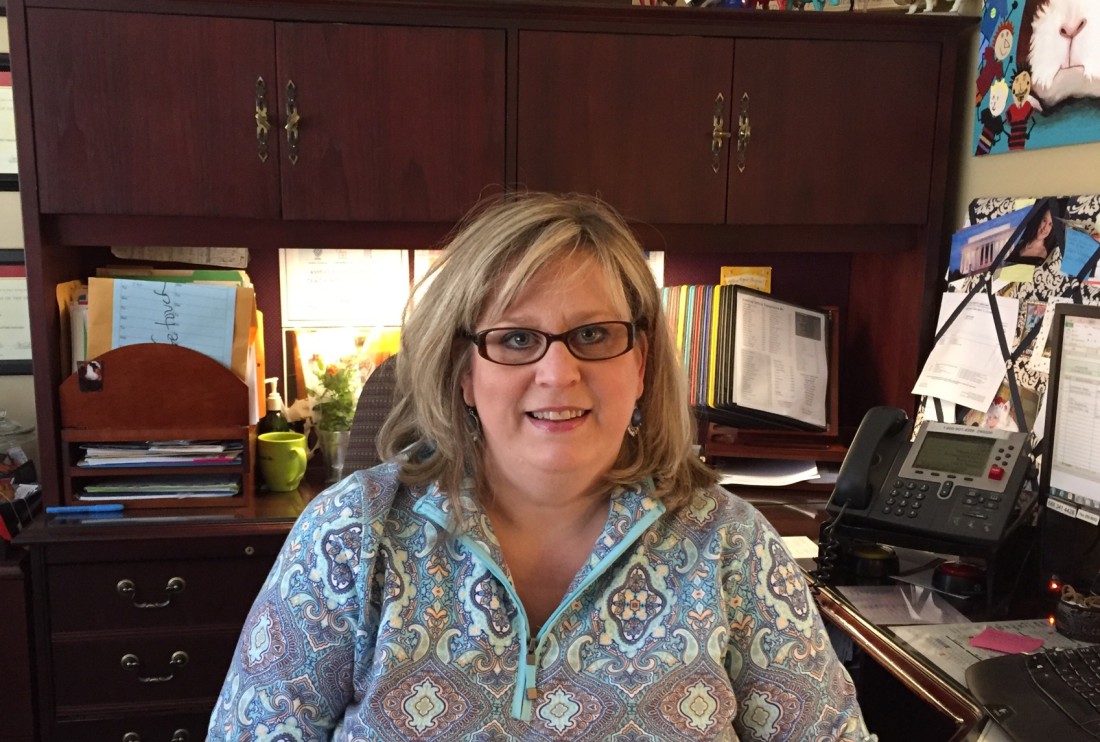School food debt caught the public eye in December when New York City writer Ashley C. Ford read about kids being denied hot lunches and resolved to do something about it. Students who’d run up large breakfast and lunch tabs, she learned, were being given a cold cheese sandwich and milk instead of a hot meal. “A cool thing you can do today is try to find out which of your schools have kids with overdue lunch accounts and pay them off,” she tweeted, and the response from her network was swift. Across the country, people called schools to donate; others raised thousands of dollars for their respective districts.
It’s also a local problem: Together, the Asheville and Buncombe County school systems have about $39,000 worth of food debt, most of it from lunches.
Public servants turned bill collectors
“School lunch balances have been around for at least the last 12 years,” notes Brad Johnson, the principal at Isaac Dickson Elementary School. Johnson and Assistant Principal Ruafika Cobb say they try to collect the money from parents.
“Kids run up huge balances because either the parents have overlooked it or they don’t realize it,” Johnson explains. “Sometimes kids move, and we’re left with a balance.” At that point, school staff go into bill collection mode.
“We send lots of notifications home,” Johnson reveals. “A social worker visits; our cafeteria worker calls homes. Most of it is just an oversight. Parents say, ‘I’ll send it in,’ and it’s taken care of.” Parents can also log in and pay or prepay online.
Several months ago, Isaac Dickson had almost $800 in lunch debt. But when Pamela Camp and Annamaria Jackson of Hill Street Baptist Church heard about it, they organized a campaign in October that raised $1,000 to pay it off. The church sits next door to Isaac Dickson, and the Rev. Keith Ogden presented the check to the school.
“We don’t deny students lunch,” notes Cobb. “But if they had a certain balance on their account, they were getting cheese sandwiches.” The donated money, she explains, “helps to pay off any balance so they can get a hot lunch.”
Helping hands
Sarah Cain, the principal at Ira B. Jones Elementary, tells a similar story. Her school currently has $900 in lunch debt, she reports. “Starting with first lady Michelle Obama, there’s been a lot of attention on what kids are eating,” says Cain. “Her Recipes for Healthy Kids competition was a big focus for us. In the Chefs Move to Schools movement, we had a partnership with the Grove Park Inn. We participated in a national cook-off and took first place in the country in the Dried Beans and Peas category for our Tuscan smoked turkey recipe.”
Nonetheless, notes Cain, “One in four children in Buncombe County live in poverty. That’s a staggering number: We feel it every day.”
Looking at a stack of papers in her hand, Cain continues, “Here’s a student who owes $85. I think to myself, ‘Is this a family who is struggling? Do I need to reach out to them?’” Other city schools give kids cheese sandwiches when their debt exceeds a certain threshold, but Jones Elementary doesn’t.
And when parents can’t pay their bills, others may step up to help. At the end of the year, parents receive notices asking them to pay off cafeteria debt, Cain explains. Occasionally, a parent who doesn’t owe anything will say, “Here’s an extra $100. Use it however you need to.”
Even that level of benevolence, though, wasn’t enough for one local parent who wishes to remain anonymous. The woman, whose daughter attends Hall Fletcher Elementary, posted on Facebook to raise funds for the school. She raised more than was needed, so she called Candler Elementary, asked about its debt, and raised the additional funds in one week.
But she isn’t finished yet. “This concept is not a long-term solution,” she points out. “I’ve already begun conversations with a local nonprofit, Community Roots, and I had a meeting with advocates for high school students to address core issues surrounding school lunch and student welfare.”
Stretching the budget
Janette Broda, nutrition director for the Asheville City Schools, says the nine schools in her district collectively owe $5,000. Broda says two people have called recently asking how they can help, and she’d love to get more such calls. “We really focus on feeding every child a nutritious, well-balanced breakfast and lunch to increase their academic performance in the classroom,” she explains. “If that’s something locals would like to contribute toward, I think it’s a worthy cause.”
Broda describes the rotating menu as a delicate balance between serving healthy meals and drawing the kids in. Breakfast offerings include oatmeal, waffles and chicken or sausage biscuits. Lunch choices include Salisbury steak, shepherd’s pie, beef and bean chili, spaghetti, pizza, hot dogs or corn dogs. “We also receive North Carolina-grown produce,” notes Broda. “We try to serve and cook local as much as we can.”
Lisa Payne, nutrition director for the Buncombe County Schools, knows how to stretch her money. In effect, she says, “I’m the general manager for 44 ‘restaurants,’ and I have a $12.5 million budget. We do everything we can to address the whole child and provide nutrition. That’s why we need the public to offset some of the balances: We don’t have a huge cash flow, and we have struggling families that cannot afford to pay those balances.”
Often, Payne continues, families don’t know they qualify for assistance. A family of three with a household income of $26,208 or less qualifies for free meals. The greater the participation in these programs, the more the schools are reimbursed. Right now, 56 percent of Buncombe County students are receiving free or reduced-price meals.
The county school system spends about $3.50 per meal, says Payne. For each free lunch served, the school system receives $3.16 in federal funding. Reduced-price lunches are reimbursed at $2.76, and for full-priced lunches, the system gets just 30 cents.
“We overspend to make sure we meet the standards of the National School Lunch Program,” Payne explains. “Every dollar we make either comes from a federal source or is generated by us, from paying students and a la carte sales.” Even the full-price meals end up costing the system money, however: Elementary school students pay just $2.40 for lunches, and middle- and high-schoolers pay $2.65.
Why it matters
“We have hunger in Buncombe County,” says Payne. “We have hungry kids, and hungry kids can’t learn.” In a partnership with the national No Kid Hungry initiative, she continues, “We do summer feedings. We go out to the community wherever the free or reduced population is 50 percent or higher.”
Payne also needs donations for Rolling to Feed, “a school bus that I want to decorate to drive around in and feed kids.”
But however it gets done, “It’s our passion to make sure that the children in our community are well-fed to receive the education that they deserve,” she says.





Students can also bring their own healthy lunches from home, right ? How about we take feeding lunch out of education and allow the parents to supply their child’s luncheon. How many million$ would THAT save yearly ? Many.
Some people have jobs, Fisher Caudle.
What’s the cost of students who can’t reach their potential because they’re hungry? Many.